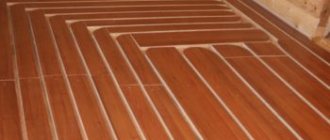A water well is most often used as a source of water for autonomous water supply. It can be used seasonally or year-round. If you plan to draw water in winter, you need to think about how to insulate the well for the winter and avoid problems with water interruptions, equipment breakdowns and pipe ruptures.
We will tell you how to thermally insulate an independent water source, eliminating the formation of ice plugs in the system. Here you will learn how to insulate a mine shaft and the water lines extending from it. Our advice will help you decide on the best method and material for insulation.
The article thoroughly examines the basic rules and subtleties of organizing a system for protecting an independent water supply from freezing. For a visual understanding of the topic, diagrams, photo illustrations, and video tutorials are attached.
When to insulate a well
In deciding how to insulate a well for the winter with your own hands outside, not the least important is the relevance of the problem itself. Thermal insulation work must be carried out only in the following cases:
- The upper part of the casing is located in a caisson pit . Water, when passing through an open section of the water pipe (coming out of the head), will turn into ice and, as a result, it will expand with subsequent damage to the system.
- The upper water level is above the freezing point of the soil. With the onset of cold weather, the pipe system will simply freeze with ice and stop working.
- Water intake is carried out by means of an electric pump , the structure of which has a return valve to retain water in the pressure pipe. When exposed to negative temperatures, icing will occur at the inlet section.
- The equipment and pump can be located in a caisson pit at a shallow depth . When exposed to cold, equipment will deteriorate.
- Due to unforeseen circumstances, the well was left unattended . The water in the system will freeze and expand, which will lead to equipment and pipeline failure.
- The design does not have a caisson pit and the casing is located at or slightly above the edge of the ground . In this case, the entire mouth of the system needs thermal insulation.
Scheme of arrangement of a well in a private house Source ht16.ru
Note! Knowledge of the properties of the materials used and the design of the well helps to properly organize the thermal insulation of a private water intake system. So, in regions with a warm climate or when laying a water pipe deeply, it is enough to cover the head with natural insulation, for example, sawdust or peat.
Classification of pumps by source of intake and principle of operation ↑
First, let's decide on the type of pump. They are classified according to the source of the fence:
- superficial;
- deep (submersible),
according to the operating principle:
- vibration;
- centrifugal.
Let's consider each option separately.
From the name it follows that such units are not immersed in water, but are located on the surface. If distance allows, it can be installed indoors or in a barn. To draw water from a well, a hose is used, one end of which is attached to a pump and the other is lowered into the water.
Some lightweight options can be installed on the surface of the water using a special float. The float can be made of foam, this will allow the unit to be in close proximity to the water without touching its surface. But more often, surface pumps are installed at a distance from the well. The suction height of such devices reaches 8 meters.
The use of an ejector allows you to greatly increase the pump pressure
Where the depth of the well exceeds these readings, you have to resort to small tricks. One option would be to use an external ejector. It is lowered into the well along with the suction hose. Part of the water raised by the pump is pumped through an additional hose into the ejector, which leads to an increase in inlet pressure.
Surface pumps are easier to dismantle and maintain. They are not exposed to moisture and are not difficult to use. Another advantage is the relatively low cost. However, the suction height of a surface pump is significantly lower than that of a deep pump.
Where the water is below 8 meters, it is more advisable to use a deep well pump. They are also called submersible, as they are lowered directly into the water. The body of such devices is made of waterproof materials and is sealed. Therefore, the depth of the well in this case does not matter.
The market for submersible pumps is now very diverse and everyone can choose a device to suit their requirements.
High pressure allows you to get water from any depth, but prohibits bringing the pump closer than 1 meter to the bottom. If you lower the submersible pump for a well, the quality of the supplied water will deteriorate. Sand and mule from the bottom will begin to flow into the hose. Over time, this can lead to mechanism failure.
In this unit, an electromagnet drives a vibrator, which ensures the movement of water through the pipes. The vibration frequency of the piston in the hydraulic chamber is 100 times per second. Due to the translational movement of the piston, the process of suction and expulsion of liquid occurs.
Internal structure of the vibration pump “Rucheek” (click to enlarge)
The vibrator is equipped with a control valve, which ensures the movement of water in the pressure pipe. The passing water protects the structural parts from overheating. Therefore, running the pump “dry” leads to breakdown of the unit. The vibration pump can only be installed on the surface. If the mechanism is installed inside the well, it will simply destroy it.
When considering deep-well units, it is better to choose a centrifugal pump for a well. The main design detail of such a pump is one or more wheels. They are located inside the housing on a shaft and consist of paired disks connected by blades.
Centrifugal pump for well
During operation of the mechanism, the space between the blades is filled with water, which is subject to centrifugal force when the wheel rotates. This force creates an area of high pressure at the edges and low pressure in the center. The pressure difference between the outside and the center forces the fluid entering the wheels through the outlet pipe.
Now let’s decide: which pump is better for a well? A surface pump is capable of raising water to a height of up to 10 m. This is the case if the unit is located in close proximity to the well. And if it is removed, it is necessary to take into account the height difference between the dynamic water level and the pump, as well as pressure losses along the entire water main. Deep pumps have a number of advantages over surface pumps. Namely:
- noiselessness;
- easier mounting of the pump in the well;
- maximum depth of application;
- ease of installation;
- battery life.
Water passing through the pump cools its parts, which prevents the equipment from overheating. Submersible pumps are equipped with float switches, which automatically turn off the engine when the water level drops below a critical level. The only drawback of deep-well pumps is the difficulty of maintenance. When carrying out maintenance and repair activities, the unit must be removed from the well. Disassembling a sealed case is more difficult. To do this, it is advisable to call a specialist.
Methods of insulation depending on seasonality of operation
Options for how to insulate a well for the winter depend primarily on how often it is used. There are 3 main types of use and corresponding methods of thermal insulation:
- Seasonal.
Typical for a country house. This implies the preservation of the system for the winter and the complete absence of any thermal insulation. Before the onset of the first cold weather, the pipes are drained and the equipment is disconnected from the power supply. In this case, the pump is turned off and all taps are opened.
- Periodic.
The water intake operates all year round, but not constantly, but in periods, for example, every other day, on weekends or holidays, etc. In this case, in addition to passive thermal materials, active heating technologies are used - heating wire. Since a long absence of flow in the pipes will lead to their rapid cooling and icing with subsequent damage.
Summer well for home Source i2-ww.ru
- Permanent.
The movement of water in the pipes occurs constantly, with the exception of short periods of downtime - at night, during the day, when everyone is at work, etc. However, the icing process can begin during extreme cold snaps, and at the peak of the cold season, and with shallow communications, and superficial location of the pump and equipment. Therefore, the use of high-quality insulation with special materials is required.
Advice! Methods and means of insulation directly depend on the climatic characteristics of the region where the well is operated. If the temperature rarely drops below -12-15°C, communications need not be immersed in the ground to great depths, but sawdust, peat, expanded clay and other natural fillers can be used as thermal insulation materials. On the contrary, in places with more extreme climates, where temperature drops to -20-30°C and below are not uncommon, it is permissible to use only professional materials - polystyrene foam, penoizol, polyurethane foam, etc.
Insulating a well for the winter from the inside Source notperfect.ru
See also: Catalog of companies that specialize in water supply and sewerage
Useful tips
- To select insulation, it is recommended to take into account the location of the future well. The climate in the region is taken into account (the depth of soil and soil freezing depends on it), the level of groundwater, the location of the well under the premises or on the land itself.
- It is recommended to take into account the location of the sewerage system.
- It is better to do drainage on the land to get rid of groundwater.
- If insulation material is used, polystyrene foam, which has specific properties, is most suitable.
Technology options
There are several technological methods for insulating a well on the street in a private house, differing in the types of materials used, system design and equipment. There are mainly 4 methods used:
- With insulation.
- With caisson.
- Without caisson.
- With heating cable.
Let's look at them in more detail.
With insulation
Thermal insulation is carried out using special materials. The method is primarily suitable for harsh climatic conditions. Its peculiarity is that the walls of the protective structure, and in some places the pipes themselves, are lined with thermal protection on the outside. The structure of the latter includes tiny isolated cavities. Thanks to them, the temperature of the internal environment is maintained at an acceptable level.
In this case, a number of requirements are imposed on the heat-insulating material:
- The structure should not absorb moisture and have a reliable water-repellent outer layer.
- The design of the insulation should not change the characteristics under pressure from soil, pipes and other objects.
- Thermal protection must be resistant to biological influences - rodents, insects, fungi and microorganisms.
External insulation of the caisson Source beton-house.com
Advice! In harsh climates, it is permissible to use only industrially produced foam materials as a heat insulator. In this case, the optimal thickness of the protective layer should be at least 0.35 m.
With caisson
The caisson is a special structure for protecting the ground part of the well. It can be either factory-made or home-made. In the first case, the product is made of reinforced concrete, plastic or metal, in the second, as a rule, it is made of boards, timber, bricks and other building materials. They can be rectangular, square, or cylindrical in shape.
Depending on the features, the caisson is insulated in two ways:
- Outside: used when it is necessary to preserve the internal usable volume, as well as protect the material of the product from external influences, for example, protect plastic from frost.
- From the inside: used when the caisson body itself is strong and completely sealed. The advantage of the method is the protection of the heat-insulating material from external influences.
Important! Passive insulation of the caisson using insulating material is not enough. For protection during periods of severe cold, a small heater is installed in it. For example, a 50 W incandescent lamp is enough to heat a standard room.
Well with plastic caisson Source plastik-da.ru
How to make thermal insulation
Installation of passive thermal insulation depends on the design features of the well. In addition, the volume of liquid lifted from the well should be taken into account. Oil wells need protection in the same way. You can use 1 of the following options:
- Construction of the caisson. It is a traditional way to protect equipment and wells operating during the winter season.
- Laying the heating cable.
- Casing pipe installation.
- Insulation of oil and water pipes using improvised means.
A caisson is a structure built around the head or oil wells. A variety of materials can be used for construction. Often the structure is made of concrete. You can speed up the construction process by choosing ready-made products made of metal or plastic.
Buildings can be of different shapes, but most often preference is given to barrel-shaped structures. Insulation of the caisson of water and oil wells can be done with your own hands; the process consists of the following steps:
- Take measurements and select a plastic container. Metal products can also be used. In some cases, you can get by with a barrel with a volume of 200 liters.
- Dig a hole around the head. Its bottom should be 45 cm below the soil freezing level, then even in severe frost the liquid in the pipes will not freeze.
- The diameter of the pit should be such that the head is about 0.5 m on each side. Cover the bottom of the hole with gravel, then add sand. You should make the pillow 10 cm thick.
- Make a hole in the bottom of the container. there will be a pipe going through it. The side of the barrel must have a hole for the pipeline.
- Place the container on the head and secure it carefully. This is how you can protect oil and water pipes.
- The junction of the head and pipe will be in the barrel. Even a pump can fit into the large frame. You can make a drainage pipe in the bottom of the barrel to drain the condensate; it will go into the soil.
- Place insulation around the barrel. It is better to use one that is immune to aggressive environments.
Polystyrene has proven itself well. You can also use mineral wool, but when choosing this material you should not forget about laying a layer of waterproofing.
Close the caisson and there should be a vent pipe attached to the lid. Be sure to cover the top of the barrel with insulation. Fill the hole. Such a frame will be an ideal option for protecting a well.
Types of materials
There is a fail-safe way to insulate and improve a well in a country house without the use of additional heating equipment - this is to cover all its components and protective structures with thermal insulation material. For professional installation, the following 4 types are used:
- Expanded polystyrene and penoplex.
- It is characterized by low thermal conductivity, strength and moisture resistance. Suitable for lining both inside and outside caissons, as well as external and underground pipes.
- Foamed polyethylene.
- It is characterized by good thermal insulation and low load resistance. Therefore, it is used for lining internal walls of rooms and external pipelines.
External insulation of a well with foamed heat insulator Source pechiexpert.ru
Well cover and wooden house
House Achieving excellent insulation results is difficult to imagine without external insulation.
After all, no matter how good the insulation is, it protects the side part. At the same time, the surface remains open and nothing prevents it from becoming covered with an ice crust. Therefore, it is advisable to place a lid or house over the neck. The covers are made of wood, which is laid on both sides of the foam insulation. The structure moves using a special cable. A well-prepared cover can protect the well from freezing throughout the cold season.
Sometimes reinforced concrete covers are used. But they also require additional insulation in the form of a layer of polystyrene foam or expanded polystyrene. This cover is secured with glue or nails.
A special solution stands out as a house for a well. This approach will allow you to create a design that is pleasing to the eye and will allow you to insulate the well. And unlike the lid, the house does not interfere with the use of the well for its intended purpose during the cold season. The roof also protects from rain and various debris that can be blown by the wind.
You can buy a house in a store or make it yourself. If you have ordinary carpentry tools, this will not be difficult. Before installing the structure, it is necessary to prepare a foundation that will prevent the structure from sagging.
Video description
For a clear overview of well insulation, watch this video:
In the standard case, the procedure consists of sequential thermal insulation of the following main elements:
Caisson
Stages of work:
- The required amount of polystyrene foam or other heat insulator is prepared.
- Next, the material is cut into the necessary fragments, based on the shape and size of the caisson.
- The outer part of the caisson is waterproofed with bitumen, unless it is made of plastic or iron.
- The prepared fragments are applied to the outer walls and secured with wire, stops, mesh or tape.
- The joints between the sheets are filled with polyurethane foam for sealing.
- Upon completion of fastening, the structure is covered with a layer of expanded clay.
Casing and cap
Subsequence:
- A box is made from pieces of chipboard, boards, plywood, sheets of metal or rigid insulation for the external closure of the casing and head.
- The box is installed on top of the casing and cap.
- Its internal space is filled with parts of mineral wool, glass wool or natural components (hay, straw, paper).
As an option, instead of a box, a cylinder is formed from a chain-link mesh with a diameter exceeding the head by 0.3 m.
Do-it-yourself well insulation Source kimberia.ru
Application of additional casing pipe
If the well is equipped with a surface-type pump, to insulate it, you can use a method that involves the use of an additional casing pipe, the implementation of which boils down to the following operations:
- First, a pit is dug around the “native” casing pipe of the source to the required depth (as in the case of a caisson).
- Next, this pipe is covered with a layer of heat-insulating material of your choice.
- Another casing pipe (slightly larger in diameter) is placed on top of the insulation.
Upon completion of these operations, all you have to do is backfill the hole.
Briefly about the main thing
Depending on the frequency of operation, there are the following ways to insulate a well on the street:
- Seasonal, when the well is not operated, but is simply drained and turned off for the winter.
- Periodic, when water is collected on weekends or once every few days. To maintain performance, heat-insulating materials and heaters are used.
- Constant, when the well is practically never idle, so the flow never stops for long. However, in cold weather, icing may begin. Therefore, professional insulation is required.
At the same time, 4 technologies are used for thermal insulation - using insulation, with a coffered structure, without it and with the installation of a heating cable. In most cases, combined methods are used. Thermal insulating materials are polystyrene foam, penoplex, polyethylene foam, mineral or glass wool, as well as penoizol, polyurethane foam and expanded clay. You can do the thermal insulation yourself, but it is better to entrust the job to a professional team.
Ratings 0
Why do you need a heating cable?
The heating cable is laid outside. You can lay it inside or outside the pipeline. The included electric cable prevents the pipes from icing up and heats the water. Heating wire can be wrapped around not only the pipeline, but also the caisson and the mouth with the tip.
Insulation on the street can be carried out with different types of electrical cables:
- resistive - supply heat with the same intensity;
- self-regulating - change the heating temperature.
The efficiency of self-regulating wires is higher because the intensity of heating of the sheath depends on the temperature of the water. By choosing this option, ineffective heat loss is reduced. In terms of price, self-regulating wires are not much more expensive than resistive wires. At the same time, they provide significant energy savings.
Typically, HDPE pipes are used to supply water to the house. The material has low thermal conductivity, so using the cable outside is less effective. When the wire is laid outside, it requires additional insulation. It protects the wire from exposure to groundwater and reduces excess heat loss.
What time of year is best to drill a water well Why?
Well passport
A very interesting question that is often asked on forums.
in fact, there is no difference when to drill - this is from the point of view of the labor intensity of the process.
But if you want it to cost you less, then it’s better to drill in winter, since at this time of year they have few orders, and they offer discounts. But if you need to drill a shallow well (20-25m), then it is better in the fall or winter, since at these times of the year the groundwater level is minimal.
Experts say that drilling a well does not depend on the time of year. Only in summer there are more orders, queues form, and prices for these works may be higher. In winter, there are fewer orders for drilling and prices are lower.
But it is best to drill wells on dry summer days or on frosty winter days, when the weather stays like this for at least ten days. During drought and frosty days (this seasonal condition is called low water), the water level drops, especially groundwater. The water may completely disappear, but it is not needed when drilling a well.
It is not recommended to drill wells during floods or after a long rainy period.
As it turns out, you can drill a well at any time of the year; this will not affect the quality of drilling. There is, of course, a point that it is more difficult to drill in winter than in summer, but this does not make the price higher; on the contrary, it will be lower in winter. Since there are a large number of orders in the summer, the price is correspondingly higher than in winter. So. You can even save your budget if you drill a well in winter.
If we are talking about a shallow well up to 25m. then it is better to drill it in the fall or winter, when the groundwater level is minimal, in this case getting into the aquifer will be most accurate.
There is one more important point, even despite the positive reviews and your ignorance of the matter, you must be present at the drilling of the well from start to finish. Even just your presence will deter workers from hackwork.
As I have repeatedly drilled wells on my estate and have used drilling equipment more than once, I will tell you that you can drill at any time of the year, aquifers will not disappear anywhere and will not change their course. Although such cases do occur, they are rare. But you need to dig a well in the spring. From experience, I know that I have dug several wells for myself and my friends, I don’t know why, but that’s what experts say. Of course, you can dig in the summer and I think that nothing will change. But for a drilling rig it makes no difference whether it is winter or summer.
Drillers almost never have any difficulties while drilling water wells. It all depends on what the wells will be drilled for - for a new house or a new well.
When starting construction in the spring, drillers always advise drilling wells in the winter. at this time the ground is frozen. There are no close groundwater, and in the spring the foundation of a new house will not be washed away. The rest of the year they look for dry water. warm weather.
Specialists rest only in rainy weather and during spring floods.
Typically, it is generally accepted that the best time to work on the ground is summer and warm autumn. But now technology has stepped far forward. And it became possible to carry out drilling work even in winter down to minus 20 degrees. Winter work has a number of advantages: absence of spring floods and rains; groundwater is at a minimum level and it is easier to enter the aquifer; the land surrounding the well will be less damaged by heavy equipment; lower cost of work.
Factors affecting heating pipes in the ground
A heating pipe buried in the soil is subject to the same influences as an external pipeline, plus factors caused by deepening:
- internal pressure of the coolant, causing circumferential and elongated tensile stresses in the pipe section;
- temperature of the coolant is a factor, in addition to thermal influence, also causing pipeline stress;
- soil temperature - in winter, taking this into account is very important;
- soil deformations - the pipe is affected by any of its displacements (settlement, shear, etc.);
- pre-bending stress of the pipeline - the ditch profile often follows the local terrain;
- vertical load - the influence of the weight of the ditch backfill layer;
- the resistive action of the soil on the walls and bottom of the pipeline - resistance to vertical load;
- vibration loads - from passing vehicles, excavation work in the neighborhood, etc.;
- moisture – precipitation and groundwater;
- the influence of chemical substances - compounds in the soil and heat carrier;
- biological factor - bacteria, decomposition.
Likewise, laying a pipeline in the soil should be carried out taking into account all the factors listed above and solving the problem of how to make heating pipes in the ground warmer.
Features of insulation installation
High-quality installation of insulation is a guarantee that the structure will serve reliably and efficiently. Depending on the chosen insulation option, installation work will differ. Wells and wells in the winter at the dacha require mandatory insulation, so we will consider the features of the foam insulation method.
Insulating a brick well with foam plastic
The easiest way to insulate a well is to use polystyrene foam or expanded polystyrene. The difference between materials is not only in price, but also in efficiency. It is recommended to use polystyrene foam or penoplex as insulation.
The principle of the work is to perform the following actions:
- Remove soil around the perimeter of the caisson to be able to place the insulation deeper.
- Measure the required size of polystyrene foam and then cut it. The thickness of expanded polystyrene depends on the region of residence, but the best option is 4-5 mm.
- You need to glue the cut sheets of polystyrene foam of the required size using special glue. To prevent the structure from falling apart in the future, it is recommended to use additional fasteners in the form of plastic mushrooms.
- Installation of fungi is carried out using a drill.
- After installing expanded polystyrene sheets around the perimeter, it is necessary to resort to the reinforcement procedure after 24 hours. For this purpose, there are also special adhesive compositions in the form of bulk materials.
- Reinforcement of the outer surface allows you to protect the insulation from external influences, as well as increase the efficiency of the structure.
Insulation of the outside of houses is carried out in a similar way. To save on this insulation option, you can line the outer wall of the caisson with polystyrene foam, and then fix it with improvised materials. This method of insulation will allow you to remove polystyrene foam in the summer.
Additional protection at the stage of installation work: how to insulate the cover
For wells with submersible pumps, the system is mothballed before long periods of downtime. To carry out this procedure, pipelines are laid with a slope towards the water source.
After the pump is turned off, it is removed from the installation, and the water returns by gravity to the well.
If this technique is used, it is important to ensure that there are no pockets where water would accumulate
It is known how the well is insulated, as well as what materials are used for the work, so it remains to understand the question of how to close the well. The top cover plays an important role, since the lack of insulation on the top cover leads to the system freezing. There are options for insulating the top cover:
- manufacturing the lid from special materials;
- insulation of the existing cover;
- production of covers from woodworking materials;
- covering the upper part of the caisson with insulating materials.
The best option is to make a cover from insulating materials. Foam or polystyrene foam is used as such material. However, to ensure structural strength, the foam cover must be covered on the outside with a protective layer. Galvanized or plastic is suitable as such a layer.
You can make a cover for a well from woodworking material, however, under the influence of water and sun, such a structure will not last long. Additional protection of the structure from weather factors will be required.
Another popular method of insulation is the use of polyurethane foam. The inner walls of the caisson are covered with polyurethane foam, which allows for not only a good degree of thermal conductivity, but also waterproofing.
Before carrying out work on installing well insulation, you need to pay special attention to factors such as the region of residence, as well as the depth of soil freezing. You need to worry about insulating the well in advance, since with the arrival of cold weather it is already difficult to carry out most construction work
Works with concrete
The bottom of the pit should be filled with grade 100 concrete. The layer thickness is 8-12 cm. To prepare such concrete, mix cement - 25 kg, crushed stone - 105 liters, sand - 75 liters and water - 20 liters. Measure proportions with a 10-liter bucket. Place the formwork. We make it from boards and place them at a distance of 20 cm from future rings. The top edge of the board should be flush with the concrete pouring. If there are no suitable boards, then hammer small nails around the perimeter of the proposed filling. Pour concrete into the pit and level it. Leave for a week to harden. We cut the pipe from the well so that it protrudes 50 cm above the surface. We seal it with foam plastic. We lay waterproofing on the concrete so that it extends beyond its edge and connect it with a torch. We cut the insulation around the pipe so that it fits snugly.
Advice! Before installing concrete rings on the well pipe, you need to thoroughly clean the joints.











